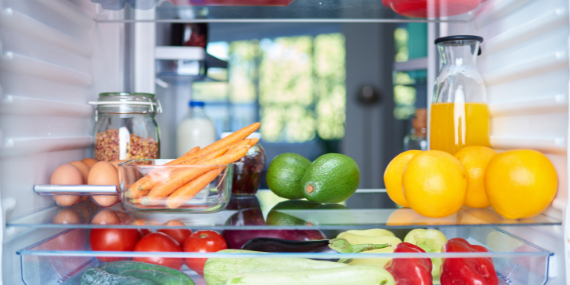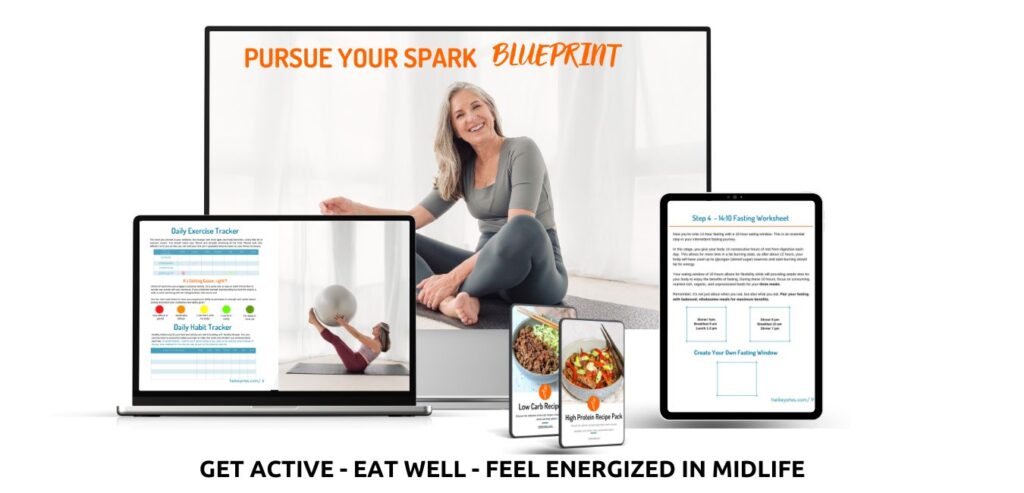When we think of spring cleaning or decluttering, we often think of our clothes, boxes in the basement, or cleaning out the garage. But how about our nutrition habits? You may have felt that your habits also need a bit of an overhaul and some close inspection. You might be stuck in old beliefs, patterns, and worries about your nutrition. Use these 5 easy tips to spring clean your nutrition habits.

I love organization! Maybe it was the way I was raised, but I am happiest when everything is in its place, and things are clean and orderly. My husband compares me with a cat who inspects everything to know that things are in the right place. So, for example, I love it when our fridge is empty except for condiments, and I can clean it out BEFORE we get new groceries. Then I organize the foods in the refrigerator, freezer, and pantry, so everything is in its’ place (well, at least the way I like it organized), and I take pride in that organization which extends to all parts of our house.
Mari Kondo’s strategy, “tidying up helps you calm down,” – works wonders for me. With the popularity of her work and in keeping with the idea of reducing clutter, it pays to declutter or spring clean your nutrition too.
Less mess = Less stress
Clutter can play an essential role in our feelings about our homes, workplaces, ourselves, and nutrition. It starts with walking into the kitchen and finding kitchen counters covered with dirty dishes, an open peanut butter jar, bread crumbs, and the knife still sitting there from the peanut butter & jelly someone made.
How can you even think about making a healthy meal if your space is messy? Messy homes, refrigerators, and pantries can leave us feeling anxious, helpless, and overwhelmed. Unfortunately, clutter is often overlooked as a significant source of stress.

Why does clutter stress us out?
- Clutter creates excessive stimuli (visual, smell, and touch). This environment makes our senses work overtime, causing undue stress.
- Messiness distracts us from what we want to focus on (creating a healthy meal).
- Clutter makes it difficult to relax, both physically and mentally.
- A messy refrigerator or panty makes us feel guilty (“I should be more organized”) and perhaps embarrassed when friends drop by unexpectedly.
- Clutter inhibits creativity and productivity to create healthy and well-balanced meals.

5 Easy Tips To Spring Clean Your Nutrition Habits
1. Declutter your kitchen
Start with a clean slate in your kitchen. Then, go through each cupboard and examine what you have:
- Throw out broken and cracked dishes or glasses.
- Pots and pans that are no longer working and lost their Teflon surface.
- Take inventory of the kitchen gadgets you bought, only used once, and never again.
- Donate items that you no longer use, but that are in good condition.

2. Declutter your fridge, freezer, and pantry.
Having stable, healthy, nutritious foods on hand will help you create better and easier meals.
- Throw out old foods that are hiding in the back of your fridge.
- Check the age of your condiments and discard the ones that you NEVER use and those that are expired.
- Clean out your fridge to have space to store your food for your next shopping trip. My easy ninja tip: I put paper towels into the veggie bins so that each time we get new vegetables, I can remove the previous dirty paper towel and replace it with a clean one.
- Do the same thing with your freezer.
- Check the quality and expiration date for pantry items like canned foods, flour, seasonings, etc.. I love keeping flour, rice, and dried pasta in glass containers on my counter; this looks pretty and organized. Also, I keep a seasoning rack in one of my drawers to have the most used seasonings right at hand when I cook.

3. Meal planning
Meal planning sounds like a lot of work for an empty-nester mom or couple. But, meal prepping and planning is a simple approach to making nutritious and delicious meals by taking out the guesswork of what to eat. It’s practical, reduces waste, saves time, is budget-friendly, and doesn’t have to be complicated. For more details, check out my post: 5 Easy Meal Prep Tips for Beginners.
Meal prepping makes it easier to control your food portions, focus on healthy recipes, and avoid processed foods. In addition, planning can help you stop ordering greasy fast food just because it’s quick and easy!
- Plan out the meals that you want to cook for the week. I recommend no more than 2 meals per week if you’re a couple.
- Choosing meals that you know you’ll eat will reduce food waste and save money.
- Purchase 2 – 3 supplemental vegetables. For example, if you make the Easy Vegan Picadillo from my favorite chef, The Minimalist Baker, you know you will have leftovers. Think about another vegetable like Butternut squash that would go with the leftovers for another meal—helping you take out the guesswork for another meal and reducing stress on what to cook next.
- Make a shopping list! You can use an app like AnyList and add the groceries you need for the week. Such an excellent way to plan your meals and reduce waste.

4. Eat mindfully
The Pursue Your Spark Blueprint course taught us about mindful and intuitive eating. We dive deep into eating mindfully and identify hunger cues and what they mean. Join us in the Empty Nest Reboot to learn more about the program.
Let me explain the difference between mindful and intuitive eating.
What is mindful eating?
Mindful eating is the practice of eating mindfully and being present while eating. That means you evaluate your reasons for hunger. For example, do you eat because you are sad, need comfort, or because it’s dinner time? Mindful eating asks you to pay attention without judging whether the food is healthy or unhealthy.
What is intuitive eating?
On the other hand, intuitive eating is a form of self-discovery of eating mindfully and without guilt. It incorporates mindful eating practices while also emphasizing the relationship between the mind (emotions), body (fitness and healthy body weight), and food (eating for nourishment and pleasure).

3 Ways to Practice Mindful Eating
- Sit down to eat: Sit instead of standing and eating at the counter or while doing chores, taking a bite each time you come by your plate. Sit down and make mealtime a habit.
- Turn off or silence all electronics: Eat and only eat. Take time to relax and enjoy the food without distractions or interruptions from electronic devices. You are paying full attention to what’s on your plate.
- Pause: Take 2-3 deep breaths before beginning a meal. Appreciate the food on your plate. Enjoy the color, aroma, and what you have on your plate, and do not devour it before you appreciate it.

5. Mentally declutter your nutrition knowledge
I’m sure you heard that “red wine is better than white wine,” “sweet potatoes are better than white potatoes,” “grains are evil,” or “spinach is better than romaine lettuce”! All those claims we hear or read on social media exhaust me. So let’s cut to the chase and aim for simple nutrition practices that anyone can do.
- Eat mostly unprocessed or at least more minimally processed foods. This means foods closest to the natural state—things like potatoes, chicken, or Brussels sprouts. Minimally processed foods are rich in fiber and protein and lower calories per volume. In addition, they are nutrient-dense, not calorie-dense, which means you can eat more of them. As a result, minimally processed foods are more nutritious, improve health, and regulate your appetite.
- It’s hard ONLY to eat minimally processed foods. Most foods are somewhere in between both categories. The more processed a food is, the fewer nutrients it contains.
- For example, an apple is an unprocessed snack, but when it becomes apple sauce it is processed a little more. It’s still good for you, but not as good as it was as a whole apple. When it is made into an apple muffin, it is processed even more and is much less nutritious than a whole apple.
- When thinking about processed foods, one thing to keep in mind is that cutting, chopping, and blending are all forms of processing. So processed foods come in various ways, and not all processed foods are bad.
Look at the foods you’re currently eating, choose slightly less processed foods, and stay away from anything bright blue that has a shelf life for over a year, or when reading the ingredients, you can’t identify most of them.

These 5 easy tips to spring clean your nutrition habits can help you feel refreshed and refocused on your health goals. Like how a messy home can cause stress, having sloppy nutrition habits can cause unnecessary stress in our healthy life goals. You can spring clean and revamp your health journey by getting yourself organized with meal planning and updating your nutrition knowledge.
Oh I so needed this advice. I need to declutter everything. I have fallen into bad habits recently. Thanks Heike.
Hilda, spring is the perfect time to take out the old and bring in the new 🙂
Love your suggestions on mindful eating!! This is something I’m definitely going to work on. And the other tips for cleaning out your kitchen, rearranging your fridge are good too.
Thank you,
Nancy
Thanks, Nancy. So glad you found this information helpful!
I loved the piece on mindful vs. intuitive eating, and the recommendation you offer. Slowing down and appreciating my meal is something I really need to incorporate into my daily habits! Great article, thank you!
Hi Susan, you’re so welcome, and I’m glad you found my post helpful.
Comments are closed.